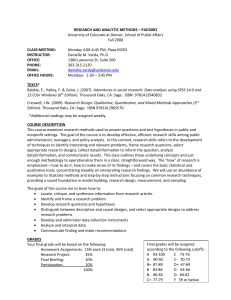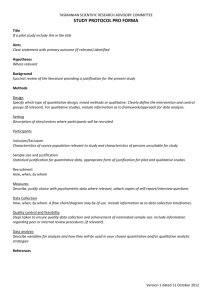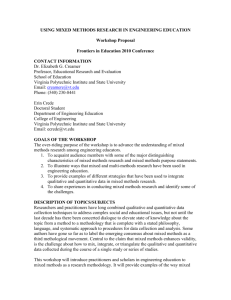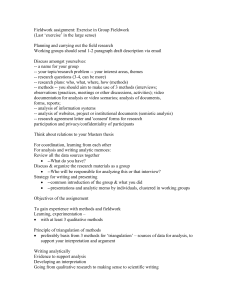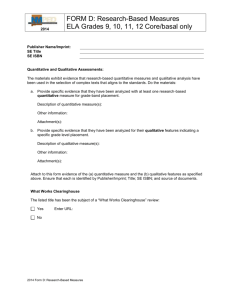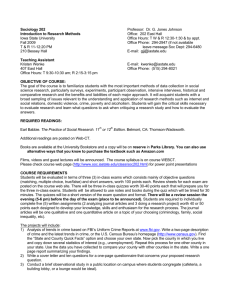PAD5003-OL1 Varda
advertisement
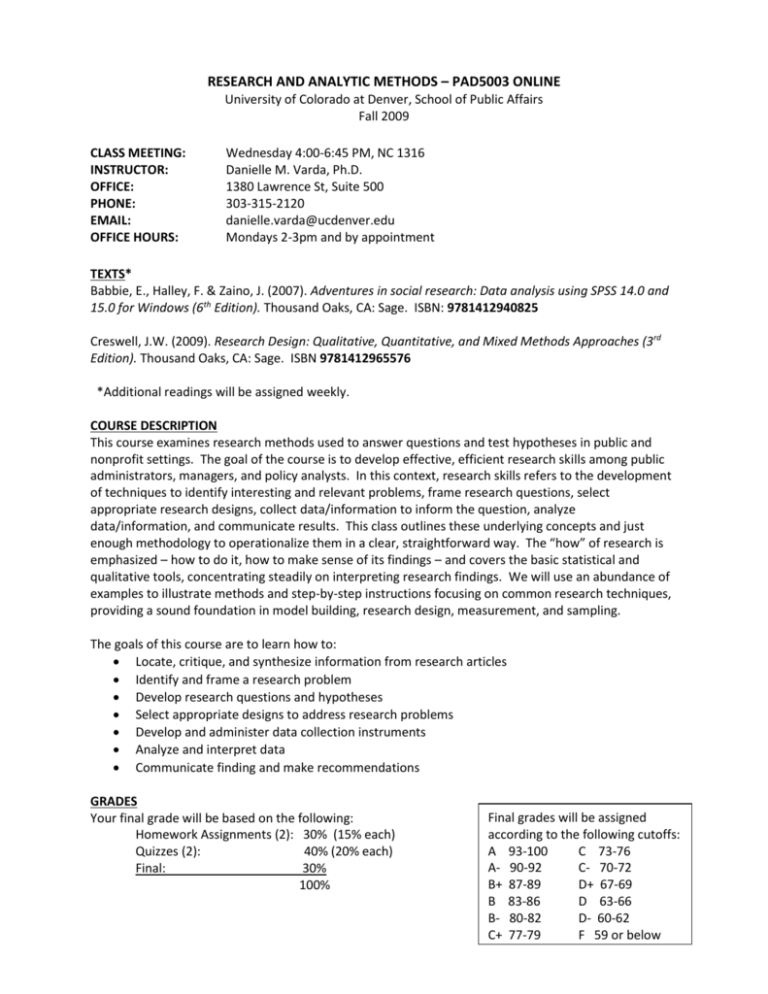
RESEARCH AND ANALYTIC METHODS – PAD5003 ONLINE University of Colorado at Denver, School of Public Affairs Fall 2009 CLASS MEETING: INSTRUCTOR: OFFICE: PHONE: EMAIL: OFFICE HOURS: Wednesday 4:00-6:45 PM, NC 1316 Danielle M. Varda, Ph.D. 1380 Lawrence St, Suite 500 303-315-2120 danielle.varda@ucdenver.edu Mondays 2-3pm and by appointment TEXTS* Babbie, E., Halley, F. & Zaino, J. (2007). Adventures in social research: Data analysis using SPSS 14.0 and 15.0 for Windows (6th Edition). Thousand Oaks, CA: Sage. ISBN: 9781412940825 Creswell, J.W. (2009). Research Design: Qualitative, Quantitative, and Mixed Methods Approaches (3rd Edition). Thousand Oaks, CA: Sage. ISBN 9781412965576 *Additional readings will be assigned weekly. COURSE DESCRIPTION This course examines research methods used to answer questions and test hypotheses in public and nonprofit settings. The goal of the course is to develop effective, efficient research skills among public administrators, managers, and policy analysts. In this context, research skills refers to the development of techniques to identify interesting and relevant problems, frame research questions, select appropriate research designs, collect data/information to inform the question, analyze data/information, and communicate results. This class outlines these underlying concepts and just enough methodology to operationalize them in a clear, straightforward way. The “how” of research is emphasized – how to do it, how to make sense of its findings – and covers the basic statistical and qualitative tools, concentrating steadily on interpreting research findings. We will use an abundance of examples to illustrate methods and step-by-step instructions focusing on common research techniques, providing a sound foundation in model building, research design, measurement, and sampling. The goals of this course are to learn how to: Locate, critique, and synthesize information from research articles Identify and frame a research problem Develop research questions and hypotheses Select appropriate designs to address research problems Develop and administer data collection instruments Analyze and interpret data Communicate finding and make recommendations GRADES Your final grade will be based on the following: Homework Assignments (2): 30% (15% each) Quizzes (2): 40% (20% each) Final: 30% 100% Final grades will be assigned according to the following cutoffs: A 93-100 C 73-76 A- 90-92 C- 70-72 B+ 87-89 D+ 67-69 B 83-86 D 63-66 B- 80-82 D- 60-62 C+ 77-79 F 59 or below Homeworks: The homeworks will ask you to demonstrate competencies and skills learned throughout the course. Homework 1 will focus on developing research questions, identifying variables, writing hypotheses, and literature reviews. Homework 2 will focus on data collection (you will create your own data collection protocol and administer it outside of class). These are each worth 15 points (30 points total toward your final grade). Quizzes: The quizzes will be in class and will test your knowledge of the quantitative section of the course. These are each worth 20 points (40 points total toward your final grade). Final: The Final will cover the entire course. It will bring together all the skills you have learned throughout the semester. This will be worth 30 points. Course Organization and Timeline: This course consists of 13 units of instruction (broken up into three modules) – research design, analytic methods, and communicating results. For each unit, there are two tasks to complete: complete the reading assignment and follow the instructions in each unit regarding assignments (these include participating in any discussions, turning in any homework assignments, and completing any quizzes/tests for that section). The instructor may add or delete sections per the needs of the class. Course Lectures/Powerpoints: Powerpoint presentations for each unit will be posted within the unit section. Written lectures will accompany (or compliment) these powerpoints. All of this is under the title "Lecture Notes" in each unit. Readings: Required readings are listed in the syllabus and within each unit. CLASS POLICY 1. The lectures, class discussions, and cases are an important part of learning. Therefore, it is up to you to complete all parts of this online course. You do not need to notify me when you get behind, it is up to you to keep up and make sure that you complete assignments and readings on time. 2. Homework, papers, and presentations not turned in on time will be reduced by one-third of a letter grade for each day it is late (for example, one third reduction represents, for example, moving from a B to a B-). Assignments are due in class on their due date. 3. Throughout the semester you will be asked to participate in group exercises, complete labs, discuss readings, share examples, and/or demonstrate techniques. Each of these are important to participate in to make sure you are getting all the necessary information and gaining all skills required to pass the course. 4. In the case of an important announcement, I will send out an email to the class, and post a note on the announcements page. One of the requirements of this course is that you maintain an email address, check it regularly for messages, be sure it is working, and let me know if you change your email address. You are responsible for any messages, including assignments and schedule changes, I send you via email. You may also contact me via email, in addition to seeing me during office hours or calling me. Please be sure I have your current email address. 5. If you send me an email, you can expect a response within 72 hours. I do not always respond to emails immediately, but instead set aside time every few days to respond to class emails. I try to set aside time on Mondays, Wednesdays, and Fridays to respond to emails. You can also visit me during office hours (or set up an appointment) to meet with me in person. ACADEMIC HONESTY As members of the University of Colorado Denver academic community, faculty and students accept the responsibility to maintain the highest standards of intellectual honesty and ethical conduct in completing all forms of academic work at the university. Plagiarism is the use of another person’s distinctive ideas or words without acknowledgement. The incorporation of another person’s work into one’s own requires appropriate identification and acknowledgment, regardless of the means of appropriation. SPA students are responsible for being attentive to or observant of campus policies about academic honesty as stated in the University’s Student Conduct Code. See the University of Colorado Denver Academic Honesty Code (attached) for more detailed information; or find it at (http://thunder1.cudenver.edu/studentlife/studentlife/discipline.html) SCHEDULE The following schedule is subject to change at the discretion of the instructor. Therefore, consider the following as a tentative schedule. UNIT/ WEEK OF Unit 1 Aug 17 - 24 Unit 2 Aug 25Sept 1 TOPIC Course Overview Introduction to Research -The Research Process -Identifying Problems -Developing Research Questions -Searching Online Databases - Literature Reviews - Research Designs: Quantitative, Qualitative, Mixed Methods - Identifying Variables - Developing Hypotheses & Propositions -Conceptual Frameworks Unit 3 Sept 2 -9 -Writing a Proposal -Ethical Issues in Research Unit 4 Sept 10-17 -Collecting Data - Unit 5 Sept 18-25 Analytic Method Topic 1: Quantitative Data -Intro to SPSS -Sampling -Validity/Reliability -Univariate Analysis Analytic Method Topic 1: Quantitative Data Univariate Statistics -Descriptive Statistics, Unit 6 Sept 26-Oct 3 READINGS – Completed by this Date ASSIGNMENTS Look through online databases using keyword searches -Creswell: Ch 1,2 -Fitzpatrick, J. (2000). “What are our goals in teaching research methods to public administrators?” Journal of Public Affairs Education. 6(3): 173-181. -Example Lit Reviews #1,2, and 3 -Cresswell: Ch 4-7 -Fontes, L.A. (1998) “Ethics in Family Violence Research: Cross-Cultural Issues.” Family Relations 47(1):53-61. -Creswell: Ch 8-10, and pages 87-94 -Hoddinott, S.N. and M.J.Bass. (1986). “The Dillman Total Design Survey Method: A SureFire Way to Get High Survey Return Rates”. Canadian Family Physician. 32: 2366-2368. Babbie: Ch 1-5 Ferris, J.M. et al. (2005) “Foundations for Los Angeles?” The Center on Philanthropy & Public Policy: Los Angeles. -Babbie: Ch 6-9 -Gazley, B. “Beyond the Contract: The Scope and Nature of Informal Government-Nonprofit Partnerships”. (2008) Public Administration Complete PARTNER survey: www.partnertool.ne t/survey Login with your username and password (will be sent to you by email). In Class Exercises Quan/Qual HW1 Distributed HW1 Due in Class LAB Unit 7 Oct 411 LAB Unit 8 Oct 1219 LAB Unit 9 Oct 2027 Graphs, & Charts Review. Jan/Feb 2008: 141-154. Analytic Method Topic 1: Quantitative Data Bivariate Statistics -Measures of Association -Tests of Significance Analytic Method Topic 1: Quantitative Data Bivariate Statistics, cont. Multivariate Statistics Babbie: Ch 11-13 -Cain, B.E. et al. (2008). “Administering the Oversees Vote”. Public Administration Review.: 802-813 Analytic Method Topic 2: Qualitative Data Data Analysis Interpreting Results -Eisenhardt, K.M. (1989) “Building Theory from Case Study Research.” The Academy of Management Review, 14(4): 532-550. -Voithofer, R. (2006). “Studying Intertextuality, Discourse, and Narratives to Conceptualize and Contextualize Online Learning Environments.” (2006) International Journal of Qualitative Studies in Education. 19(2): 201-219. -de Graff, G. and L.W.J.C. Huberts. (2008). “Portraying the Nature of Corruption Using an Explorative Case Study Design”. Public Administration Review. 640-653. -Lindlof, T.R. “Creating and Analyzing Texts in the Field” in Qualitative Communication Research Methods, Vol 3, Sage:Thousand Oaks. 197-243. -DeNardo, A.M. and L.L. Levers. “Using NVivo to Analyze Qualitative Data”. See link on Blackboard. -In addition to the readings, please also go to this link and read this: http://www.idrc.ca/en/ev-106563-201-1DO_TOPIC.html -Granovetter, M. (1973). “The Strength of Weak Ties”. The American Journal of Sociology. 78(6): 1360-1380. -Kapucu, N. (2005). “Interorganizational Coordination in Dynamic Context” Connections 26(2): 33-48. -Krebs, V. and J. Holley. (2006). “Building Smart Communities Through Network Weaving” http://www.orgnet.com/BuildingNetworks.pdf. -Krackhardt, D. and J.R. Hanson. (1993). “Informal Networks” Harvard Business Review:104-111. -Social Networks in the News. Find a news article on social networks and bring to class. Unit 10 Oct 28Nov 4 Analytic Method Topic 2: Qualitative Data Data Collection Kristi Jackson Coming to Present NVivo Unit 11 Nov 512 Analytic Method Topic 3: Relational Data Core Concepts Data Collection Unit 12 Nov 13-20 Analytic Method Topic 3: Relational Data Data Analysis Interpreting Results (In Class Simulation) LAB QUIZ (in class) Babbie: Ch 14-15, 17-18 -McPherson, M., et al. (2006). “Social Isolation in America” American Sociological Review 71: 353-375. QUIZ (in class) HW2Distributed HW2 Due in Class Final Distributed NO CLASS Nov 21-28 Unit 13 Nov 29-Dec 6 FALL BREAK Dec 79 FINAL Mixed Methods Communicating Results Making Recommendations Briefing Your Results -Johnson, R.B. and A.J. Onwuegbuzie. (2004). “Mixed Methods Research: A Research Paradigm Whose Time Has Come.” Educational Researcher. 33(7): 14-26. -Driscoll, D.L. et al. (2007). “Merging Qualitative and Quantitative Data in Mixed Methods Research: How To and Why Not.” Ecological and Environmental Anthropology 3(1): 19-28. -“Communicating Research Results: Tips for Preparing and Making Oral Presentations”, http://www.hawaii.edu/acadsci. -Policy Brief Examples; -White Paper Examples Final Due Dec 9
